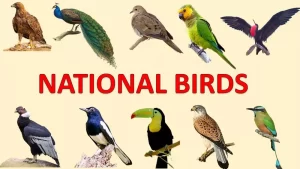National Bird
A national bird is a species officially chosen by a country to represent its heritage, values, or identity—much like a national flag or anthem, but in feathered form.

Native to the country (found there naturally and often associated with its landscapes)
Culturally significant (appears in folklore, art, or traditional stories)
Symbolic of national traits (e.g., strength, freedom, peace, resilience)
Why it matters:
Cultural identity – It reflects the country’s traditions, beliefs, and values.
National pride – Seeing the bird in nature or in national symbols can foster unity.
Conservation awareness – Choosing a species as a national emblem can motivate efforts to protect it and its habitat.
Global recognition – It becomes a visual shorthand for the nation, much like the American bald eagle or India’s peacock.
In short, a national bird is part cultural mascot, part conservation ambassador, and part national brand—wearing feathers instead of a suit.
List of National Birds
| Country | National Bird | Symbolism |
|---|---|---|
| United States | Bald Eagle | Strength, freedom, independence; chosen for its majestic appearance and wide range in North America. |
| India | Indian Peafowl (Peacock) | Beauty, grace, pride; appears in Hindu mythology and is associated with gods and royalty. |
| Philippines | Philippine Eagle | Power, uniqueness, and biodiversity; one of the rarest eagles, symbolizing the country’s rich wildlife. |
| Mexico | Golden Eagle | Courage and cultural heritage; central to Aztec legend about the founding of Tenochtitlán. |
| Japan | Green Pheasant | Cultural tradition; mentioned in folklore and known for its distinctive call and vibrant plumage. |
| New Zealand | Kiwi | Uniqueness, resilience; a flightless bird found only in New Zealand, also a nickname for the people themselves. |
| South Africa | Blue Crane | Elegance and balance; revered in local cultures and a symbol of peace and prosperity. |
| Costa Rica | Clay-colored Thrush | Simplicity and connection to nature; known for its beautiful song that marks the start of the rainy season. |
Frequently Asked Questions
1. What is the largest eagle?
The Philippine eagle (Pithecophaga jefferyi) is often considered the largest in terms of length and wingspan combined. It can reach over 3 feet (about 1 meter) in height, with a wingspan of up to 7 feet (2.1 meters). In terms of sheer weight, the Steller’s sea eagle can be heavier, weighing up to 20 pounds (9 kg).
2. What is the US national flower?
The national flower of the United States is the rose. It was designated as such in 1986 for its beauty, cultural significance, and historical symbolism.
3. Do bald eagles mate for life?
Yes. Bald eagles typically form long-term pair bonds and mate for life. If one partner dies, the surviving eagle will usually find another mate.
4. Why is the bald eagle called “bald”?
The term “bald” in this context comes from an older English word, piebald, meaning “white-headed.” Adult bald eagles have striking white feathers on their heads and tails, contrasting sharply with their dark brown bodies.

 Facebook
Facebook  Instagram
Instagram  Youtube
Youtube 